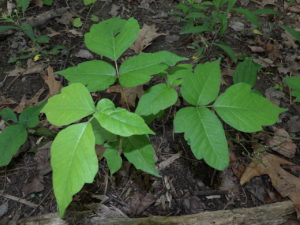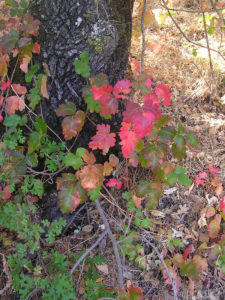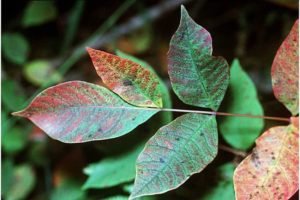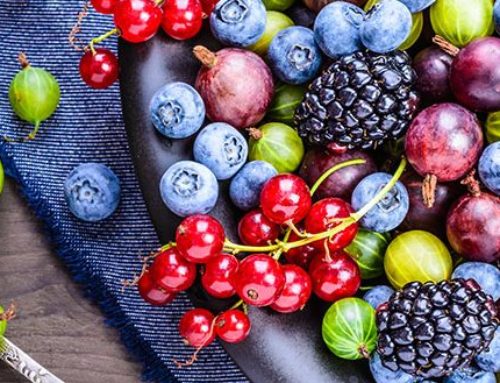Itching for Relief
If you ever started scratching and suddenly noticed a blotchy red spot on your skin you may have thought to yourself “how did that happen?” Unfortunately, there are several ways to pick up an itch while your outdoors enjoying nature during warmer months. While most skin irritations are treatable, the best way to stay itch free is to know what to look out for and what to avoid. Here are plants that might leave you scratching if you don’t steer clear.
Poison Ivy

Poison Ivy
Poison Ivy gets a lot of the lime light when it comes to itchy plants and for good reason. Poison Ivy is well known for causing an itching, irritating, and sometimes painful rash for those unlucky enough to come in contact with it. An oily organic allergen in the plant’s sap called urushiol is responsible for the allergic skin rash many experience on contact.[1] Poison Ivy can generally be identified by clusters of three leaflets, a lack of thorns, and because each group of three leaflets grows on its own stem which connects to the main vine.[2]
Poison Oak

Poison Oak
Poison oak is also known as Pacific poison oak or western poison oak. It’s a woody vine or shrub and is generally found in western North American forests, woodlands and grasslands. Like it’s distant cousin Poison Ivy it can cause an itchy allergenic rash when touched or if one is unfortunate enough to breath in smoke from a burning shrub. [3] Poison oak has three leaves with scalloped edges which look very similar to traditional oak leaves. The leaves can be bronze, bright green, yellow- green or reddish and can produce greenish-white or tan berries. [4]
Poison Sumac

Poison Sumac
Poison sumac is a shrub or small tree and can grow up to 30 feet high! The leaves generally contain anywhere from 7 – 13 leaflets which can be anywhere from 2 to 4 inches long. Just like Poison Oak, Poison Sumac can cause skin irritation to anyone who comes in contact with it and breathing in smoke from a Posion Sumac can cause a rash to appear in the lining of the lungs and, in serious cases, may even cause death.[5] Poison Sumac is most widely found in the Southern U.S. although they can also be found along parts of the Eastern Seaboard, as far north as Wisconsin and as far west as Texas.
Treatments
All three of the plants mentioned here contain urushiol, which in most people, causes a skin rash and allergic reaction known as urushiol-induced contact dermatitis.[6] There are two phases to treating a skin rash based on contact with Poison Ivy, Oak or Sumac. The first phase is to wash the affected area with soap, water and a wash cloth as soon as possible. The soap and water are necessary to remove the urushiol oil from the skin and scrubbing with a wash cloth is important because the urushiol can strongly adhere to the skin.[7]
For minor cases and temporary relief from itching and inflammation, apply an over the counter topical cream like Dr. Greenfield’s Burn N Bite. For more severe or extreme reactions seek medical attention.
Summary
To have an “itch free” summer, it pays to be observant and avoid coming in contact with Poison Ivy, Oak or Sumac. However, if you develop an allergic reaction to any of these plants remember:
- Wash the area with soap and water;
- Scrub with a wash cloth;
- For minor irritation apply a topical cream to relieve itching and inflammation;
- For more extreme reactions see medical attention.
Disclaimer: SelfCare Plus sells Dr. Greenfield’s Burn N Bite product direct to consumers.
References
- https://en.wikipedia.org/wiki/Urushiol
- https://en.wikipedia.org/wiki/Toxicodendron_radicans
- https://en.wikipedia.org/wiki/Toxicodendron_diversilobum
- http://www.teclabsinc.com/tips-info/images-video/images/poison-plant-identification/
- https://commons.wikimedia.org/wiki/File:Toxicodendron_vernix.jpg
- https://en.wikipedia.org/wiki/Urushiol
- https://en.wikipedia.org/wiki/Urushiol-induced_contact_dermatitis#Treatments
Images Attribution
- “Foliage of poison ivy” by Broly0 is licensed under the Creative Commons CC0 1.0 Universal Public Domain Dedication
- “PoisonOak wb biggerLeaves” By Elf at English Wikipedia, CC BY-SA 3.0, https://commons.wikimedia.org/w/index.php?curid=6059118
- “Poison Sumac” This image or file is a work of a United States Department of Agriculture employee, taken or made as part of that person’s official duties. As a work of the U.S. federal government, the image is in the public domain.




